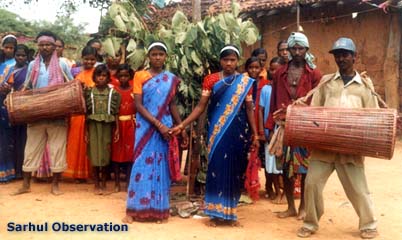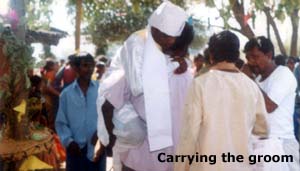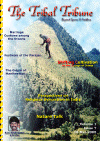Marriage Customs among The Oraons
|
The Oraon is the largest populated tribal group (1048064 as per 1991 census) of the Chotnagpur plateau in Jharkhand (earlier in Bihar) state of India. These tribal people are mainly concentrated in rural areas of Ranchi, Gumla, Lohardaga, Hazaribagh and Palamu districts of the state and they have been living with other tribal and Hindu caste people since long past. However with the passage of time, they have migrated to different parts of the country during pre and post Independent era in search of their livelihood (as manual labour). They have their own language called Kurukh, which belongs to the Dravidian linguistic family (Grierson 1927). The people like to follow their traditional life and culture which is reflected in their material culture namely house type, household utensils, furniture, dress, ornaments, tattoo marks, agricultural, hunting and fishing implements, musical instruments, food and drinks etc.; economic organization i.e. division of labour on the basis of age and gender, method of paddy cultivation, strong social organization, socialization process, political and religious organization, customary laws etc. They have passed through gathering stage and later on developed .the settled agricultural economy. (Vidiyarthi 1981:85). The society is patriarchal, patrilinial. They follow the age-old culture, tradition, customs and value system in their life. The people have totemic clans or gotra, which are named after birds, animals, fishes, plants, vegetables and minerals. (Archer 1940, Schwalbe 1983, Roy 1984, 1985, Srivastava 1992, Duary 1999). Their marriage is strictly clan exogamy and tribe endogamy. They strongly follow birth, marriage and death rituals, ceremonies and feast at their residence in the presence of community members and relatives. The village level political organization is called parha which consists of a number of posts viz. Pahan (village religious priest), Panibharwa (assistant of Pahan for carrying water and other religious essentials), Pujar (assistant of Pahan), Bhandari and Chowkidar. Each has a particular role to play in the religious ceremonies, festivals and feasts and for solving any kind of dispute at the village level. The traditional informal, educational institution youth dormitory Dhumkuria is no longer in its original form and function but has been replaced by a community house (Sahay and Duary 1998:24-25). The public and common meeting place Akhra is located in front of the Dhumkuria where they meet for the purpose of discussion and solving any kind of disputes. Moreover, the people of both the genders, at this place, sing and dance together accompanied with musical instruments like nagara, dholki, khel, tiryo, murli, bhanree, theehka, and jharj in all festivals and religious occasions. The religion followed by them is called Sarna. The religious place Jhakra is centrally located within the village where traditional deity Chalapachu resides. The foul sacrifice and other offerings are made at this place in her name on the occasion of Sarhul festival. They have strong belief in their traditional deities namely Chalapachu or Jhakrabudi, Dharmesh, Gaondevi, Mahadania etc. and also keep faith on ghost, spirit and evil eye equally. The major religious festivals of the Oraon are Sarhul,
Karma, Murmajatra and hunting or sikar. The sikar festivals are Bisu sikar, Phagu sikar. Mukra sikar. They also celebrate a number of agricultural festivals like Dhanbuni, Harihari, Nayakhani, Khariyani etc. They have their oral tradition related to their origin, migration, culture and society and have their own indigenous knowledge to preserve the environment and cure the disease and sickness by use of their traditional pharmacopia. This tribe is now well organized for revival of their culture, the fading institutions and tradition. The Oraon have distinct characteristic features unlike other tribal communities of the area. Their manner of invitation, salutation, organizing feast as well as gift offering on the marriage occasion, differentiate them from other neighboring tribals namely Munda, Mahali, Chick Baraik, Lohra and Kharia. They receive their guests in a manner, which reflects their warm feeling towards others. The refinement of Oraon culture can be exemplified from the intricacies of their marriage customs. As marriage involves social tie between two families, the etiquette of inviting many other families into kin bondage, highlights their cultural standard. The Oraon people on every social occasion invite the community members and relatives to share their joy, emotion, blessing, co-operation and participation. On the marriage ceremony they take part in this auspicious occasion and interact with other, relatives and invitees. The traditional way of invitation for marriage ceremony (both boy and girl) is made with smearing of turmeric and sun dried rice i.e. newta tikhil. A few days before the marriage ceremony the women carry the newta tikhil in her anchol (end part of the veil of the saree) and offer the same to the invitees at their residences who receive it in their anchol.
On the occasion of the marriage, the relatives bring with them rice beer handia in an earthen pot ardi, rice, vegetables in bamboo basket called doura on his/her head. The handia is considered to be one of the most essential items in every socio-religious occasion as offerings to the deities as well as entertaining guests as symbol of honor. The host has to feed all. In order to reduce the burden on host family, the relatives carry the edible gifts. This is an unique example of sharing responsibility. The guests come to the groom’s house on the chumawan ritual (on the day of blessing) whereas the relatives of bride start arriving on the day of marriage or a day before.
After that the unmarried girls of the host's family request the invitees to sit on a pirda (small wooden stool) at chali and wash their feet on a daram chhipa (brass plate) pouring water from a brass container (lota) and then anoint their feet and hands with moni essung (mastered oil). The invitees keep some small coins on the daram chhipa as token of receiving honor. The lady collects the coins, throwing the water on the roof of the house. Another woman collects the down running water on her anchol as blessing. This custom is performed mainly to give honor to the guest as well to provide relaxation to his/her tiredness of their long journey on foot. This process is followed with the invitation by the house owner to enter the house and taking seat on chatai (palm leaves mat). They are offered drinking water in a brass lota, khaini (tobacco leaf), chuna (lime stone paste) and handia along with chakhna (wet gram) in a dona (sal leaf bowl). On the day of marriage the bride party welcome the groom and his party from Janamasadda in a traditional ritual pawchhana. Janamasadda is a place of bride's village where groom party stay before coming to the bride's house for marriage. This is a nice welcoming procession consisting of community members, relatives and guests. They perform the benja nalna (marriage dance) and songs by both the genders accompanied with musical instruments and played by Mahalis. One male person carries a lighted torch made of a sickle wrapped round at its blade with old cotton cloth and placed in daram chhipa containing moni essung and keeps a few coins in it. An old married lady carries a brass lota (coated with abdatikhil paste on it) on her head over a khejur bindo (date palm leaves pad). The lota is filled with water, where a mango twig with 5-7 leaves is put dipping the stalk in the pot. Another married lady carries an earthen pot (kalash) decorated with sheaves of paddy and gendapunp (marigold flower). After reaching the procession at Janamasadda the lady first sprinkles the water from the lota with the mango twig on the head of the groom. Then show the auspicious light to him and lastly one young man carries the groom on his shoulder from this place to madwa (a temporary shed made with green sakhua ie. Shorea rohusta branches where marriage takes place).
A mutual cooperation is always seen in each and every stage of marriage ceremony since selection of bride and groom. This kind of cooperation is better reflected in the marriage feast where irrespective of their gender, experience, and expatriation everyone willingly comes forward to lend their hands. Women help in the preparation of sal leaf sorda (plate), dona and jhara keta (bowl) where as the men help in cooking as well as distributing food and water. The food usually comprises of ardka tikhil (boiled rice), aamkhil (vegetable curry), dali (pulse), khasi ahra (mutton) etc. Food items are served to the people sitting in a row at the chali. The Oraon people still follow the traditional customs and manners as their social values due to integrated social organization and customary practices. This is explicit in marriage invitation process, reception of guest, relatives, sharing experience, contribution and their cooperation for better conduct of the marriage ceremony. Moreover, we observe the role and status of women. The young generation also follows their age-old tradition with instruction from elder and experienced members of the society. Like other human societies, Oraons are also not immune to change. The neighboring Hindu and Christian people have influenced many changes. Except for utilizing modern facilities, these Oraon people, have tried to maintain their cultural tradition. |
Photograph Source : Kaleswar Oraon,Rourkela.
Note:
References :
-
Archer, W.G. 1940 'Notes on two Oraon Marriages', Man in India, vol. 20.
- Duary, Nabakumar 1999 'Oraon Dances in Chotnagpur: An impact Study’, Tribal Dances of India, Eds-Robin D. Tribhuwan and Preeti R. Tribhuwan, New Delhi, Discovery Publishing House
- Grierson, G.A. 1927 Linguistic Survey of India, Introductory, Calcutta, Central Publication Branch, Govt of India. vol.1. Part - I
- Roy S.C. 1984 The Oraons of Chotnagpur, Man in India Office, Ranchi Catholic Press, (First Published in 1915)
- 1985 Oraon Religion and Customs, Delhi, Gian Publishing House, (First Published in 1928).
- Sahay, Vijoy S and Nabakumar Duary 1998 'The Fading Traditional Tribal Institutions of Chotangapur: A study of the Oraons and the Mundas' Vamyajati, vol. XLY, No. 4
- Schwadbe, Lydin lake 1983 Die Munda and Oraon in Chota Nagpur : Geschichte, Berlin, Wirtschaft and Gesellschaft Akademic-Verlag.
- Srivastava, A.R.N. 1992 Chaning Values and Tribal Societies, New Delhi, Inter India Publication
- Vidyarthi, L.P. 1981 A Socio-Cultural Profile of the Oraon of Chotanagpur, Plural Societies, vol.1 & 2 No.122.








